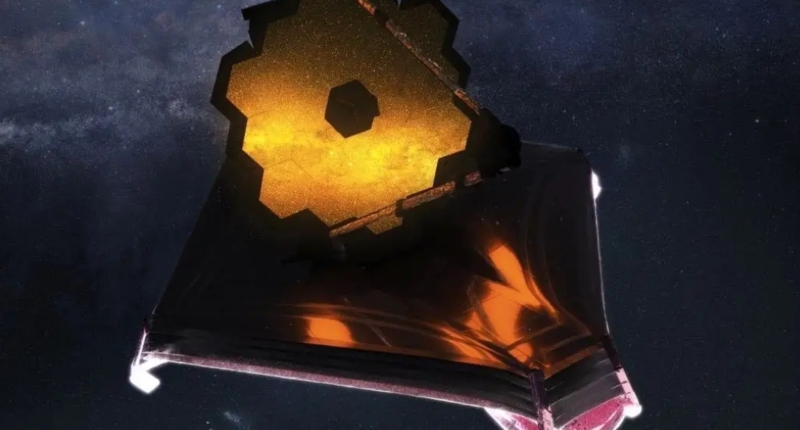NASA’s James Webb Space Telescope is set to observe exoplanets with the help of its coronagraphs, which can directly detect planets around other stars. The telescope’s Near-Infrared Camera (NIRCam) and Mid-Infrared Instrument (MIRI) coronagraphic modes use coronagraphs that block a distant star’s light while allowing faint planet light to reach its sensors. Additionally, Webb’s coronagraphs can observe objects as close as 0.13 arcseconds from the star, and as distant as about 30 arcseconds from the star. However, Webb’s coronagraphs cannot remove all of a star’s light, so astronomers will use a variety of “point spread function (PSF) subtraction methods” to remove the last remnants of light. Webb’s coronagraphs are uniquely suited to study faint objects in the infrared, including dense circumstellar disks of debris generated by asteroids and comets in exoplanetary systems. However, to image planets like our own around nearby Sun-like stars, a future mission fully optimized around next-generation coronagraphs will be necessary.
The James Webb Space Telescope is on a mission to investigate exoplanets, and the examination of these distant worlds is at the core of its scientific goals. Christopher Stark, the Deputy Observatory Project Scientist from NASA’s Goddard Space Flight Center, recently shed light on one of the most effective methods employed by Webb to accomplish this feat.
Although there are several modes of observation used by the telescope to study planets orbiting other stars, one particularly useful method is direct detection. Directly detecting planets located far away is an enormous challenge, and even the nearest stars are so far away that their planets appear to be separated by a fraction of the width of a human hair held at arm’s length. This makes it impossible to observe the planet’s faint light as it gets lost in the glare of its host star.
However, Webb has the ideal tools for the job, with the Near-Infrared Camera (NIRCam) and Mid-Infrared Instrument (MIRI) coronagraphic modes. Webb’s coronagraphs are capable of blocking the light emanating from a distant star while permitting the faint planet light to reach its sensors. It’s similar to how drivers use the visor in their cars during sunrise or sunset to see the cars in front of them, except that Webb employs a much more advanced “visor.”
By blocking out the star’s light, Webb can capture the planet’s faint light, which is typically overwhelmed by the glare of its host star. Furthermore, the coronagraph masks in the pupil plane prevent the exoplanet from displaying Webb’s hallmark six-spiked diffraction pattern. Webb NIRCam and MIRI coronagraphic images of the exoplanet HIP 65426 b provide a good example of this phenomenon. The white star symbol on the image indicates the position of the star, which was blocked out by the coronagraphs.
In conclusion, Webb’s coronagraphs are instrumental in enabling scientists to directly detect exoplanets, which is no easy task. By employing these sophisticated technologies, the telescope has taken us one step closer to understanding the mysteries of the distant worlds in our universe.
Understanding Webb’s Optics: The Importance of Pupil and Image Planes
To optimize performance, all of Webb’s coronagraphs physically mask out unwanted starlight in both the image and pupil planes. The image plane is where the distant sky, including all astrophysical objects, is in focus. Most of Webb’s image plane masks, resembling opaque spots or bars, remove starlight by blocking it in the image. However, due to the wave nature of light, these masks can’t entirely block the star’s light.
To remove much of the remaining starlight, Webb uses additional pupil plane masks, also known as Lyot stops. These masks are located at the pupil plane, which allows the surface of the primary mirror to be in focus. These masks look very different from the hexagonal primary mirror, which is the telescope’s “pupil.”
Webb’s NIRCam instrument has five coronagraphic masks, each of which can be configured to observe at different wavelengths ranging from 1.7 to 5 microns. Webb’s MIRI instrument has four coronagraphic masks that operate at fixed wavelengths between 10 and 23 microns. The coronagraphs can observe objects as close as 0.13 arcseconds from the star and as distant as about 30 arcseconds from the star, which roughly translates to circumstellar distances ranging from a few Astronomical Units (AU) to hundreds of AU around nearby stars.
The exception to the image plane masks is MIRI’s “four-quadrant phase masks,” which shift the wave-tops of one part of the wave of light, so it cancels out with another part through a process called “destructive interference.” This method ensures that objects imaged with the coronagraphs do not display Webb’s hallmark six-spiked diffraction pattern.
In conclusion, understanding the importance of the pupil and image planes in Webb’s optics is essential to optimize its performance. With sophisticated masks in both planes, the telescope can directly observe distant sky and astrophysical objects, including exoplanets, with remarkable accuracy.
Webb’s Coronagraphs: Revealing Distant Worlds with Advanced Techniques
Webb’s coronagraphs are integral to the telescope’s scientific objectives, particularly the examination of exoplanets. While these sophisticated instruments can block a star’s light in both the image and pupil planes, they don’t remove it perfectly. To remove the last remnants of light, astronomers use a variety of “point spread function (PSF) subtraction methods,” which measure the pattern of residual starlight and then subtract it from the science image. The resulting pattern is noisy, limiting the faintest detectable exoplanet.
During commissioning, Webb’s NIRCam and MIRI coronagraphs demonstrated contrasts better than 10^-5 and 10^-4 at 1 arcsecond separation, respectively. Despite their limitations, Webb’s coronagraphs are still unique in their ability to study faint objects in the infrared, making them an ideal complement to other instruments that observe at different wavelengths.
Webb’s coronagraphs are mainly used to detect giant extrasolar planets that are still warm from being formed. They can also image dense circumstellar disks of debris generated by asteroids and comets in these exoplanetary systems, as well as protoplanetary disks in which planets are still forming. Webb’s coronagraphs can even be used for extragalactic astronomy, to study host galaxies containing bright active galactic nuclei.
While Webb’s coronagraphs can reveal much about planetary systems, they won’t be able to image planets like our own around nearby Sun-like stars. To detect these planets, we’ll need to observe even closer to the star and detect planets just one ten billionth the brightness of the star. NASA’s upcoming Nancy Grace Roman Space Telescope will carry a technology demonstration instrument to test next-generation coronagraph technology, and the agency is laying the groundwork for further technology development for a Habitable Worlds Observatory mission concept. This future telescope would be as large as Webb, operating in the same wavelengths as Hubble, but designed to find truly Earth-like exoplanets around other stars and search them for signs of life.
In conclusion, Webb’s coronagraphs are an essential tool in the study of exoplanets and other faint objects in the infrared. While they have limitations, their advanced techniques can reveal many secrets about distant worlds, and they will continue to be complemented by future technologies aimed at detecting even more elusive exoplanets.
Author: Christopher Stark, Webb Deputy Observatory Project Scientist, NASA Goddard.
Don’t miss interesting posts on Famousbio










